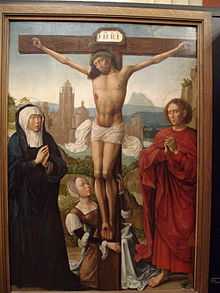Triclavianism
Triclavianism is the belief that three nails were used to crucify Jesus Christ. The exact number of Holy Nails has been a matter of theological debate for centuries.[1]
Albigenses and Waldenses
Triclavianism was one of the beliefs attributed to Albigenses and Waldensians, who held that three nails were used to crucify Christ and that a Roman soldier pierced him with a spear on the left side.
The 19th century Anglican scholar George Stanley Faber claimed that Pope Innocent III declared this to be a heresy and maintained that four nails were used and Jesus was pierced on the right side. This was repeated in historical works such as Sofia Bompiani's A Short History of the Italian Waldenses.[2] Faber's book does not quote any primary source, and does not give the name or date of the document of Innocent III. Other scholarly treatments of the subject, such as Herbert Thurston's article in the 1914 Catholic Encyclopedia, make no mention of any such document.

George Stanley Faber's account of the history in his 1838 work An Inquiry into the History and Theology of the Ancient Vallenses and Albigenses: As Exhibiting, Agreeably to the Promises, The Perpetuity of the Sincere Church of Christ is as follows:
- I am not without some suspicion, that the circumstance of the Noble Lesson mentioning the five wounds of Christ, while it is silent as to the number of nails employed, affords another incidental testimony to the correctness of its date.
- Lucas of Tuy, in the thirteenth century, is very large on this subject. He tells us, that the world had turned to many false opinions: and he specially enumerates, the alleged Docetism of the Albigenses which denied that Christ had truly suffered in the flesh, and the unsound tenet unauthoritatively advanced by other sectaries that three nails only were used in the crucifixion and that the left side (not the right side) of our Lord was pierced by the spear.
- This last opinion was advocated from about the latter end of the eleventh century: but Pope Innocent III finally and infallibly determined, that four nails were used, and that the Roman soldier pierced the right side of Christ; a decision, which of course stamped the brand of heresy upon Triclavianism.
- The judgement of the Pope was confirmed by a miracle: and, as a decisive proof that four nails were used and that the right side was pierced, Lucas of Tuy brings forward the remarkable case of St. Francis Assissi, upon whose body were preternaturally impressed the five wounds of our Savior, in such a manner, that the semblance of the heads of four nails appeared in the inside of the two hands and on the outside of the two feet, while there was so real a wound on the right side that it often emitted blood.
- Now this saint was the founder of one of the two Orders which were started by Innocent III against the Humiliated and the Poor Men of Lyons: and as a part of the project, he contrived, we see, to mark himself in such a manner, as to bear a sort of practical testimony against the old triclavian heresy of those whom he was appointed specially to oppose. All parties acknowledged five wounds: but the semblance of four rusty nail-heads on the hands and feet of Francis were, of course, proof positive, that four of the wounds were inflicted by four nails and not by three.
- Such an argument would not have been used against those whom Francis was appointed to oppose, unless they had believed that three nails were employed: and, accordingly more than a century earlier, the author of the Noble Lesson, whom I suppose to have been a Triclavian, mentions the five wounds; but, probably in order to avoid giving needless offence is silent as to the number of the nails, and specifies not whether the right side, or the left side was pierced.[3]
[From footnote on pages 396-8. Emphasis is Faber's.]
Representation in art
Though in the Middle Ages, the crucifixion of Christ typically depicted four nails, beginning in the thirteenth century, some Western art began to represent Christ on the cross with his feet placed one over the other and pierced with single nail.[1] The poem Christus patiens attributed to St. Gregory Nazianzus and the writings of Nonnus and Socrates of Constantinople also speak of three nails.[1]
The three nails, as a symbol for the crucifixion of Jesus Christ, are also used on the coats of arms of Drahovce, Slovakia, Saint Saviour, Jersey, St. Clement Parish, Ottawa and in the seal of the Society of Jesus.
The plant Passiflora edulis (Passion fruit) was given the name by early European explorers because the flower's complex structure and pattern reminded them of symbols associated with the passion of Christ. It was said that the flower contained the lashes received by Christ, the crown of thorns, the column, the five wounds and the three nails.[4]
See also
References
- ↑ 1.0 1.1 1.2 Thurston, H. (1911). "Holy Nails". Catholic Encyclopedia. New York: Robert Appleton Company.
- ↑ Bompiani, Sofia (1899). A Short History of the Italian Waldenses: Who Have Inhabited the Valleys of the Cottian Alps from Ancient Times to the Present. Barnes. p. 38.
- ↑ Faber, George Stanley (1838). An Inquiry into the History and Theology of the Ancient Vallenses and Albigenses: As Exhibiting, Agreeably to the Promises, The Perpetuity of the Sincere Church of Christ. R.B. Seeley & W. Burnside. pp. 396–8.
- ↑ Coe, Sophie D. (1994). America's first cuisines. p. 187. ISBN 0-292-71159-X.
External links
- Holy Nails—Entry from the Catholic Encyclopedia discussing the number of nails used.